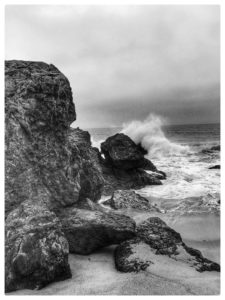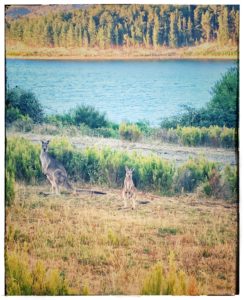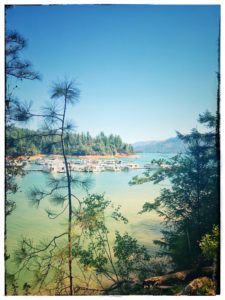I was searching my phone for pictures of Natural Bridges State Park when I realized the word “state park” pulls up hundreds of photos my hubby and I have taken. I searched for “national parks” and “state beaches,” and there were hundreds more. Going through old pictures, and compiling this timeline, gave me a new perspective on all the places I take for granted every weekend and vacation. Each place was protected by someone on purpose.
This timeline might seem a little choppy. What does the world population have to do with oil spills or the national parks movement? They’re not directly related, but I hope you’ll see the correlation. The disasters happen in parallel with the protections. Global warming is happening alongside the greatest inventions. It’s all related. So here’s a historical timeline of environmental protections, disasters, and the industrial revolution.
I believe that the more you know about the past, the better you are prepared for the future. ~ President Theodore Roosevelt
The Environmental Movement
1700’s
– The world population is about 610,000,000.
– The industrial revolution begins in England.
1800’s
1804 – The world population reaches one billion.
1857 – The US oil boom begins in Pennsylvania.
1862 – The US Homestead Act gives 270 million acres of federal land to encourage Western expansion.

1872 – Yellowstone becomes the first national park, starting a worldwide national parks movement.
1879 – Thomas Edison invents the electric light bulb.
1880 – Modern record-keeping of surface temperatures begins.
1884 – The worlds first skyscraper is built in Chicago.
1885 – Niagra Falls becomes the first state park in the United States.
1892 – John Muir becomes the first president of the Sierra Club.
Climb the mountains and get their good tidings. Nature’s peace will flow into you as sunshine into trees. ~ John Muir
1900’s
1900 – The global population hits 1.6 billion.
1901 – 1909 – President Theodore Roosevelt conserves about 230 million acres of US land by creating national parks, federal bird reserves, national forests, and monuments. He is called the “conservationist president.”
We have become great because of the lavish use of our resources. But the time has come to inquire seriously what will happen when our forests are gone, when the coal, the iron, the oil, and the gas are exhausted, when the soils have still further impoverished and washed into the streams, polluting the rivers, denuding the fields and obstructing navigation. ~ President Theodore Roosevelt
1908 – Henry Ford starts selling the Model T.

1920’s – Aldo Leopold develops the idea of wildlife management and environmental ethics.
Of what avail are forty freedoms without a blank spot on the map? ~ Aldo Leopold
1922 – The Sierra Club publishes Ansel Adams photos.
Life is your art. An open, aware heart is your camera. A oneness with your world is your film. Your bright eyes and easy smile is your museum. ~ Ansel Adams
1923 – Employment in the coal mining industry hits its peak in the US with 883,000 coal miners.
1926 – Kruger National Park in South Africa is established.
1936 – Fuji-Hakone-Izu National Park is established in Japan.
1947 – Los Angeles County creates the first anti-air pollution agency.
1951 – There are 2.5 billion people on earth (that’s almost an additional billion people from 50 years earlier).
1961 – The Maasai Mara National Reserve is established in Kenya.
1962 – Rachel Carson’s Silent Spring paints a frightening picture of the fast and dangerous rise of industrial chemicals and pesticides in our food, homes, and bodies.
If we are going to live so intimately with these chemicals eating and drinking them, taking them into the very marrow of our bones – we had better know something about their nature and their power. ~ Rachel Carson
1963 – National Geographic publishes “My Life Among the Wild Chimpanzees” by Jane Goodall.
The greatest danger to our future is apathy. ~ Jane Goodall

1970 – Congress establishes the Clean Air Act of 1970.
1970 – The first Earth Day.
1970 – The Environmental Protection Agency is created.
I have become further convinced that the 1970’s absolutely must be the years when America pays its debt to the past by reclaiming the purity of its air, its waters, and our living environment. It is literally now or never. ~ President Richard Nixon
1979 – Now there are 4.3 billion people (that’s an extra 1.8 billion in 29 years). It’s also the year I was born.
1986 – Major nuclear plant disaster in Chernobyl (in the former USSR).
1987 – Our Common Future becomes “a global agenda for change” for the United Nations.
The “environment” is where we all live; and “development” is what we all do in attempting to improve our lot within that abode. The two are inseparable. ~ Gro Harlem Brundtland, Our Common Future
1987 – The Montreal Protocol is created to phase out ozone-depleting substances such as chlorofluorocarbons (CFC’s). CFC’s were used as coolants (aka Freon) in refrigerators and air conditioners and propellants in aerosol cans. The protocol is credited with significantly reducing the hole in the ozone layer.
The Montreal protocol is a model of cooperation. It is a product of the recognition and international consensus that ozone depletion is a global problem, both in terms of its causes and its effects. ~ Ronald Reagan, Statement on Signing the Montreal Protocol on Ozone-Depleting Substances

1989 – The Exxon Valdez Oil Spill released 11 million gallons of oil off the coast of Alaska.
1992 – The UN Earth Summit in Rio de Janeiro establishes Agenda 21, a sustainable development plan for the 21st century.
1997 – Kyoto Protocol discussions begin to control and reduce greenhouse gases. The US and China do not sign on.
2000 – Natural Capitalism – Creating the Next Industrial Revolution is published. It’s the best book on how to create a green industrial revolution if you ask me.
2002 – Brazil launched the Amazon Region Protected Areas program to protect 150 billion acres of rainforest.
2004 – The Nobel Peace Prize goes to Wangari Maathai for her work on sustainable development, democracy and peace in Africa.
Protecting and restoring the environment contributes to peace; it is peace work. ~ Wangari Maathai

2010 – The Deepwater Horizon spills 200 million gallons of oil into the Gulf of Mexico.
2012 – Tesla’s all-electric Model S is released.
2013 – The Fukushima Daiichi nuclear disaster happens in Japan.
2015
- The Paris Agreement is signed by almost every country in the world to keep global warming below two degrees Celsius.
Our work, here and now, gave future generations cleaner air, and cleaner water, and a more sustainable planet. And what could be more important than that? ~ President Barack Obama’s Statement on the Paris Climate Agreement
- It’s the second warmest year on record with a temperature anomaly of .90 degrees Celsius, 1.62 degrees Fahrenheit.
- Bill Gates launches The Breakthrough Energy Coalition and Venture to invest in R&D of clean energy technology.
- The Sixth Extinction – An Unnatural History
by Elizabeth Kolbert wins the Pulitzer Prize.

2016
- The Kigali Amendment is signed and begins phasing out hydrofluorocarbons (HFCs) in the United States in 2019. HFC’s are greenhouse gases used as refrigerant alternatives to the ozone-depleting CFCs phased out by the Montreal Protocol. Phasing out and properly disposing of refrigerants such as HFC’s is the most impactful solution to slowing climate change according to Drawdown.org.
- It’s the warmest year on record with a temperature anomaly of 1.68 F, 0.94 C.
Since 1880, surface temperature has risen at an average pace of 0.13°F (0.07°C) every 10 years for a net warming of 1.69°F (0.94°C) through 2016. ~ Climate.gov
2017
- Pages about climate change are deleted and edited from several government websites such as the EPA.gov under President Donald Trump’s direction.
This page is being updated. Thank you for your interest in this topic. We are currently updating our website to reflect EPA’s priorities under the leadership of President Trump and Administrator Pruitt. ~ Former EPA.gov page about climate change.
- Trump announces the US will withdraw from the Paris Agreement.
- There are now about 7.5 billion people on earth. That’s almost an additional seven billion people since the start of the industrial revolution. That’s a lot of people.
- It’s the third-warmest year on record, with a temperature anomaly of .84 C, 1.51 F.
We need to revise our economic thinking to give full value to our natural resources. This revised economics will stabilize both the theory and the practice of free-market capitalism. ~ Paul Hawken, author of Drawdown.
That’s It, For Now
History never stops, so this is a living document. I’ll keep adding to it. If there’s an important event or person I missed, please post in the comments section, and I’ll update it.
The point in history at which we stand is full of promise and danger. The world will either move forward toward unity and widely shared prosperity – or it will move apart. ~ President Franklin D. Roosevelt
